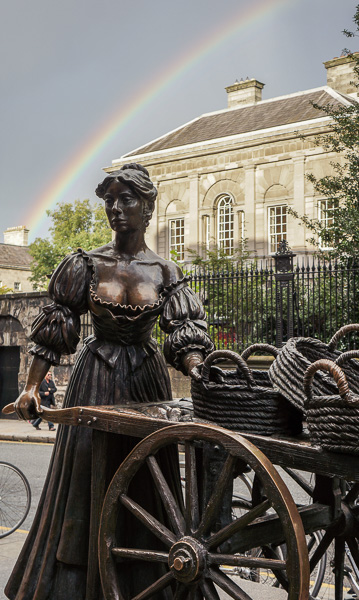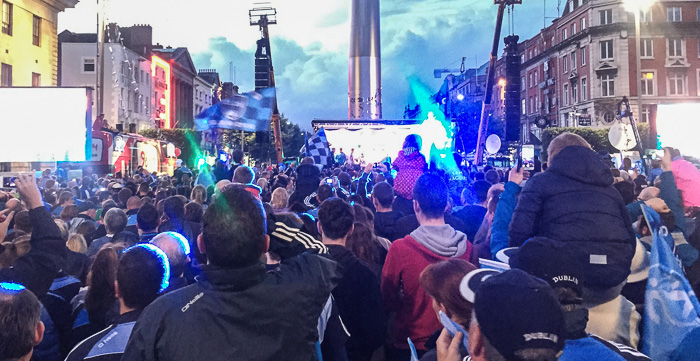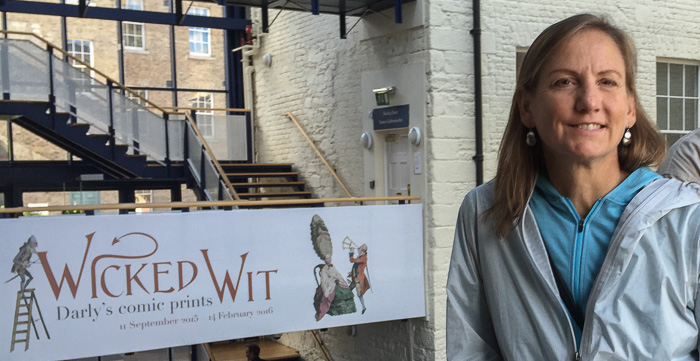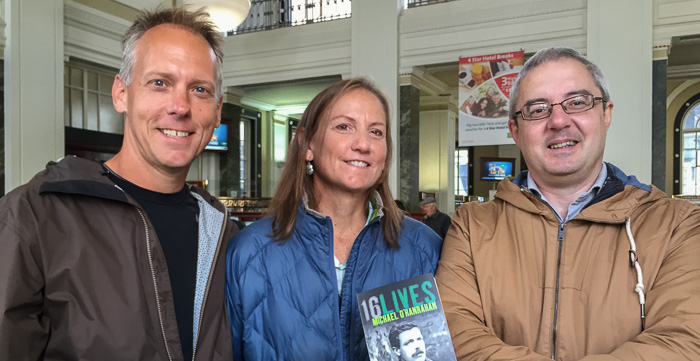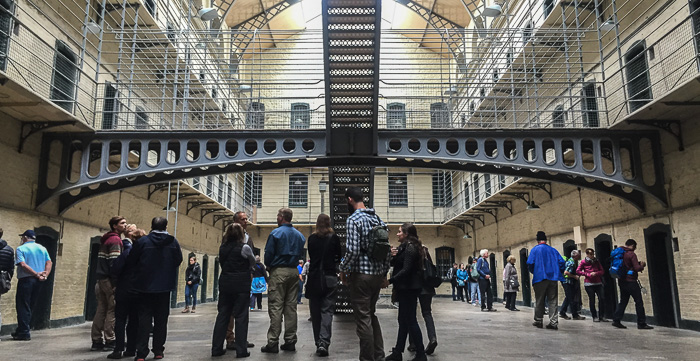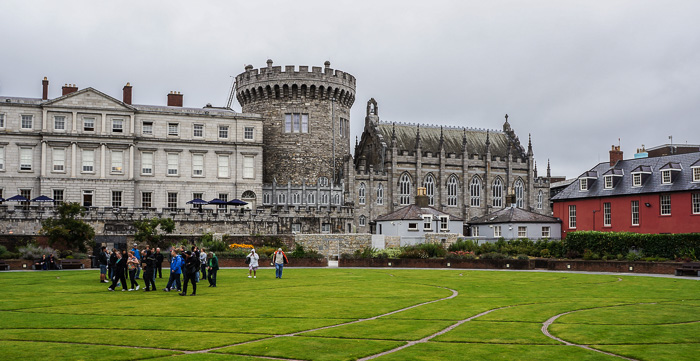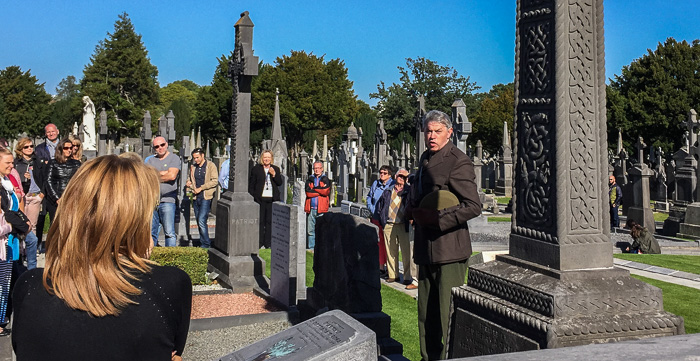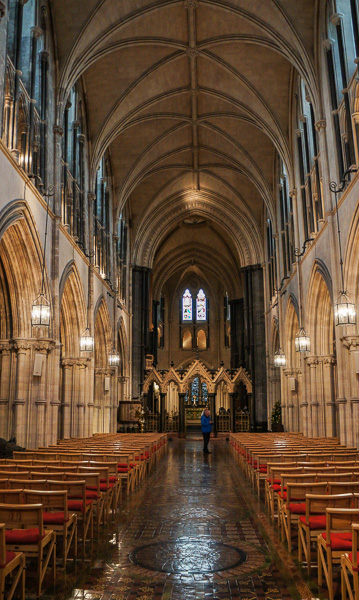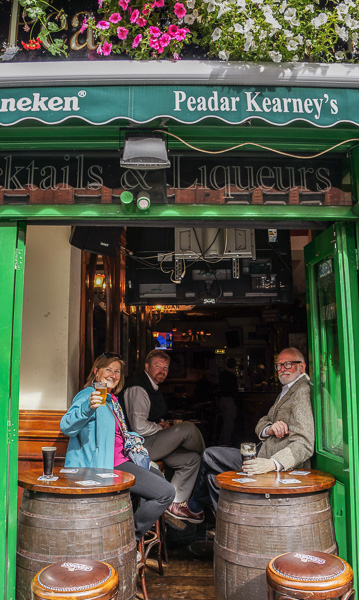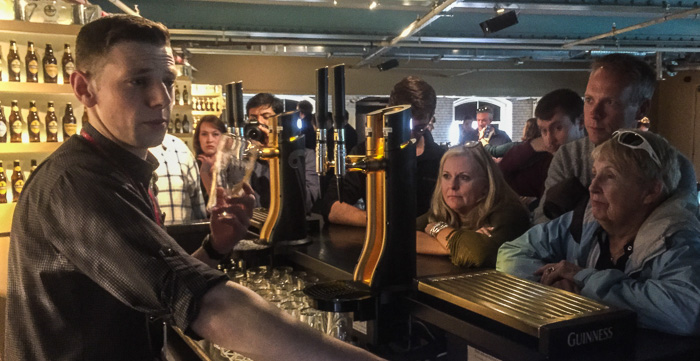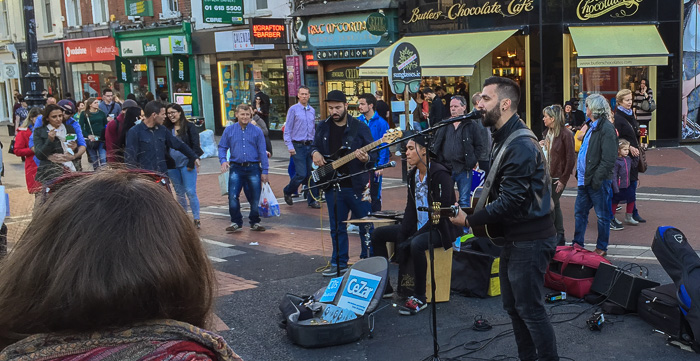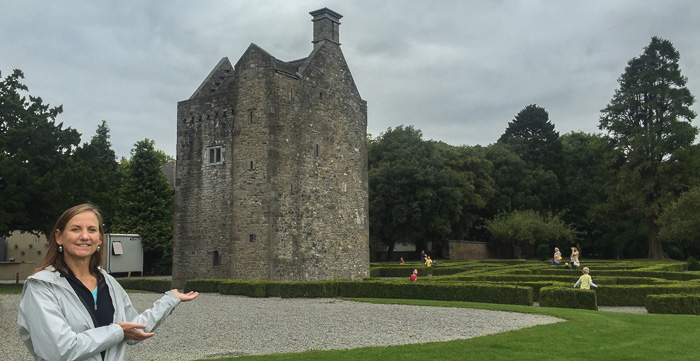Sightseeing in Dublin: In Dublin’s Fair City, Where the Girls are so Pretty…
…I first set my eyes on sweet Molly Malone. Really. There’s a rather voluptuous statue of her on Suffolk Street in Dublin. During our week tromping around the city we passed her more than once, and each time I broke out in song; it’s practically an involuntary response.
There’s so much to do and see in Dublin, this threatens to be a monster post. I’ll try to stick to the highlights, keep descriptions brief, and discuss Irish music in a separate article. Before getting to specific sights and tours, I’ll share one lesson learned regarding how to enjoy Dublin: open your eyes, pay attention, and be flexible. Three of my favorite memories weren’t planned; we grabbed opportunities as they presented themselves:
- “Up the Dubs” rally on O’Connell Street: Dublin won the All-Ireland Senior Football Championship and the city held a rally for the team. We read of the event online and joined hundreds of fans for a televised street party with live band. Good wholesome fun, even if not a diehard fan.
- Free “Bloody Sunday” Lecture: Karen noticed posters for the Dublin Festival of History, researched further online, and reserved seats for a free lecture. Five of us listened to a fascinating panel discussion and Q&A regarding “Bloody Sunday 1920: The Day that Shook Dublin” while the rest of our group took a tour of Dublin Castle.
- Free Darly Exhibit at the Chester Beatty Library: We were strolling the Dublin Castle grounds when Dave noticed a banner for “Wicked Wit: Darly’s Comic Prints”. We spent 30 entertaining minutes reading humorous and often biting comic strips laced with political and social commentary from the late 1700s.
Now on to more “traditional” sightseeing and tips which I’ve broken into four categories: History, Churches and Cathedrals, Beer and Whiskey, and Getting Around.
History
Ireland’s tumultuous history can be difficult to sort out. For me, each tour added new tidbits or repeated information in a way that helped solidify concepts and increase understanding. These are my favorites:
- 1916 Rebellion Walking Tour: A two-hour walking tour that left from The International Bar and finished at the General Post Office on O’Connell Street. How better to digest a violent battle in Dublin’s streets than to actually walk Dublin’s streets? Our guide, Conor Kostick, did a masterful job of distilling this important piece of Irish revolutionary history down to an understandable and compelling narrative. Highly recommend! (€13/person)
- Kilmainham Gaol: A former prison, this one-hour tour covers “some of the most heroic and tragic events in Ireland’s emergence as a modern nation”. Indeed. Fourteen men from the 1916 Easter Rising were executed at Kilmainham Gaol. I found it very valuable to take this tour after the 1916 Rebellion Walking Tour (above). (€4/adult; free with OPW Heritage Card)
- Dublin Castle: Not much remains of Dublin’s original medieval castle, but the one-hour tour begins with the undercroft and its early history. The castle was severely damaged by fire in the late 1600s and by then, a stronghold was no longer necessary. The State Apartments you see today were built to house a British administrative center and to provide the Viceroy with a lavish place to live and entertain. The tour covers the gothic Chapel Royal, courtyard, and beautifully decorated State Apartments. A statue of Lady Justice stands high above the courtyard entrance facing inward. Our guide recited a little ditty that illustrates how many Irish felt about British rule: “Lady Justice, mark her station, face to the castle, arse to the nation”. Ha! In 1922, the Irish Free State was born and Michael Collins was given the keys to the city in a ceremony in the great courtyard. The tour touches on this and other moments in Ireland’s struggle for independence. It’s quite poignant, especially after learning about the Easter Uprising and subsequent executions. (€8.50/adult; free with OPW Heritage Card))
- Glasnevin Cemetery and Museum: I was hot to visit Glasnevin once we learned of daily live re-enactments of Padraic Pearse’s historic speech at Jeremiah O’Donovan Rossa’s funeral. The funeral was used as a platform to garner support for an Irish Republic, and Pearse’s stirring oration concludes “…Ireland unfree shall never be at peace.” It gave me chills! The re-enactment was one small part of a tour that’s practically a who’s who of Irish history. We heard tales of Daniel O’Connell (the Great Emancipator), Charles Stewart Parnell, Michael Collins, Eamon de Valera, and many more. Our guide was one of the most knowledgeable and passionate I’ve ever had, almost too much so. My brain was full after two hours and we left the tour early - that’s right, it was still going at the two-hour mark! With over a million buried at Glasnevin, there’s lot to talk about. (€10/adult)
- National Museum of Ireland - Archaeology: I have two words for you: bog bodies. Perhaps not for the squeamish, but fascinating! The “Kingship and Sacrifice” exhibit offers several mummified remains, the oldest dating to 2000BC. Ireland’s peat bogs have yielded a treasure trove of ancient artifacts; the cold, acidic, oxygen-deprived environment prevents decay. To see more items pulled from the bogs, visit the 2nd floor balcony alcove. I also particularly enjoyed the Clontarf exhibit which dissects the famous battle where Brian Boru purportedly defeated the Vikings. Of course the museum holds much, much more, but there’s no pressure to “get your money’s worth” - it’s free! Spend hours, or pop in for a few minutes. (Free; closed Mondays)
Finally, walking tours are a popular way to get a general overview of the city and its history, not just a specific slice of it as with the 1916 Rebellion Tour. Free tours are available through Sandeman and although we didn't partake, three free walking tours were thrown in with our hop-on-hop-off sightseeing bus pass. Since we had a party of ten, we hired a walking-tour guide through Tours by Locals. Hiring a personal guide allows for customization. In our case, we split the tour over two days, a few hours one afternoon and the rest the next morning.
Churches and Cathedrals
One of my travel companions has zero interest in cathedrals stating “if you’ve seen one, you’ve seen them all.” I agree to a point. If you’re visiting more of Ireland and have limited time in Dublin, consider skipping the cathedrals. There’s a lovely church or cathedral in practically every town, and most are open, welcoming, and free. If you want to be wowed in Dublin, the two big draws are Christ Church Cathedral (€6/adult) and St. Patrick’s Cathedral (€6/adult). I’ve never visited St. Patrick’s, the final resting place of Jonathan Swift, but Christ Church is inspiring and the crypt below is the earliest surviving structure in the city and offers a short movie, church artifacts, a cafe and shop.
On my next trip to Ireland - there will be a next time! - I’ll make a point to tour St. Michan’s Church (€4/adult). Karen and I wandered into St. Michan’s (among others) on an early morning walkabout and a quick spin through revealed that Handel may have fine-tuned the Messiah on a small organ displayed in the back. Interesting, but not why I’ll return. On our way out, we had a brief chat with two gift shop clerks who couldn’t believe we’d leave without taking the crypt tour. Unlike the crypt in Christ Church, here you can see mysteriously mummified remains from the 17th–19th centuries and learn of Dublin’s influential families. The bodies weren’t embalmed or stored in peat (!), just a limestone vault. I believe the tour focuses on a few remains, but many coffins have deteriorated over time revealing preserved corpses within. If you go, be courteous; some have criticized visitors’ disrespect for the dead.
Beer and Whiskey
With 6 weeks in Ireland, Chris and I sampled many a pint and shot. A few pub tips:
- Pick a pub, any pub, and duck in. If you don’t like it, move on and try another. Each pub has a unique character. Keep going ’til you find one that suits.
- If you’re in a social mood, sit at the bar and stay awhile. The longer you sit, the more likely a conversation will ensue.
- Before ordering beer on tap, note what others are drinking and follow suit. Lines go bad if used infrequently. Seriously! I learned of this phenomenon from a bartender in Tralee after questioning why beers taste different from pub to pub. I’ve had a few just a titch “off”, but others so sour they were undrinkable.
- Ask locals where to get the best pint. This can be hilarious! Folks take their beer (especially Guinness) very seriously. Our townhouse was one block from Hartigan’s Pub; one patron swore it had the best pint in Dublin.
We also took in a couple tours:
- Guinness Storehouse: Although a must-see for many, I found the Storehouse overwhelming; it’s a cavernous, echoing space filled with hoards of tourists. We were there on a Friday in late September (“shoulder” season) and it was still gonzo. The tour is self-guiding for the most part, requiring additional Disney-like queuing for tasting and pouring. I was anxious to escape the din, but still lingered in “World of Advertising” watching old ads, and “Cooperage and Transport” studying the fine art of barrel-making. The “Guinness Academy” was a high point, learning to pour a proper pint. Naturally, drinking said pint was delightful. Last stop, the 7th floor Gravity bar where we elbowed our way to the windows for a superb 360-view of Dublin. The experience took two hours all-in and my mom summarized: “Today was a good day. I thought I was going to die a couple times, but it was a good day.” ($20/adult which includes complimentary pint of Guinness; highly recommend advanced booking)
- Irish Whiskey Museum: Since I’m a Jameson fan, you’d think I’d hit their tour, but Chris’s research steered us to the Irish Whiskey Museum. It costs the same (€15/adult), but tells the more general story of “Irish whiskey through the ages” and ends with a sampling of three (non-Jameson) whiskeys. This tour was more my speed, with only 15 or so in our group, and a personal guide leading us through a one-hour experience that covered not only the distilling process, but whiskey’s role in Irish history and impact on the country’s economy. It was entertaining and informative and I’d visit again, but I still prefer Jameson whiskey!
Getting Around
As in many large cities, driving in Dublin isn’t recommended; streets are crowded and parking can be scarce and expensive. Cars aren’t necessary anyway, with most major sights within a one-mile radius of downtown. In our one week in Dublin, we traveled mostly on foot, but also by public bus, hop-on-hop-off sightseeing bus, and taxi:
- Walk: If weather, time and energy cooperate, this is my favorite way to explore. Walking affords the opportunity to slow down, notice details, discover hidden treasures, and indulge whims. Walking led us to the Garden of Remembrance, street cart BBQ from The Goode Life Food Company, Grafton Street buskers (best near dusk), and traditional Irish music at The Old Storehouse. Getting to far-flung sights may seem daunting, but even the furthest aren’t really that far. From St. Stephen’s Green, Kilmainham Gaol is just 2.3 miles with Dublin Castle and the Guinness Storehouse along the way. If nothing else, think of the calorie burn. You gotta earn those fish & chips!
- Public Bus: We rode the Dublin Bus just once with a group of five. Buses are everywhere, but require patience, exact change, and some understanding of routes. To find which buses to use, we consulted Google Maps in conjunction with the Dublin Bus Route Planner. The ride from St. Stephen's Green to Kilmainham Gaol cost €2.55 each way per person which led to a pre-bus mission to multiple convenience stores, each time purchasing gum and candy to break bills and ultimately collect 10 total fares of exactly €2.55 each. Yet another unexpected fond memory!
- Hop On Hop Off Sightseeing Bus: With limited time and a mixed-energy party of ten, we tried the City Sightseeing Dublin hop-on-hop-off bus. It was a smokin’ deal at €15 for 48 hours and stopped near all the big sights, but I’d hesitate to do it again. Traffic was a nightmare and we spent way too much time sitting on the bus. Given positive reviews online, I’m wondering if our experience was atypical; the entire city seemed to be under construction in anticipation of the 100th anniversary of the 1916 rebellion. If I had a do-over, I’d at least walk to all city-center sights and catch the bus on its way out where congestion eases. One final warning: Karen and I took the bus to see Ashtown Castle in Pheonix Park, but the bus stops at the Duke of Wellington obelisk, a brisk 30-minute walk away. We arrived at the castle just after the last tour, but a generous OPW guide gave us a personal tour of the tower house “discovered” in 1978 when the larger surrounding building was demolished (!).
- Taxi: Taxis can be expensive, but let’s face it, when you’re done you’re done. This was another hard lesson learned. On a big international trip, a few taxi fares will get lost in the noise, so if you need one, get one. Also carefully check for belongings before paying. Jennifer dropped her phone in a taxi and we spent a fruitless week attempting to track it down.
That’s our Dublin sightseeing in a nutshell. Next up, trad music - what it is, where to find it, tips for listening, and more. One piece of advice: Don’t wear yourself out during the day, or if you do, take a nap to get a second wind. The music scene in Dublin is outstanding!
